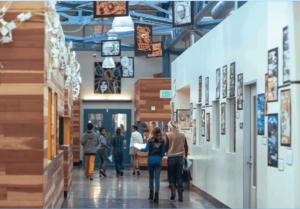10 Resources to Promote Personalized Learning

A couple people called last week looking for advice for state and district leaders on personalized learning. Here’s a recap of our conversations.
1. What Role Should States Play in the Shift to Personalized Learning? It just so happens that we wrote a blog with our friends from Learning Accelerator with that title a couple weeks ago–it suggested developing proof points to build support for a policy update.
At a blended learning conference on the Stanford campus last Friday, several of us recommended that the most important starting point for states and districts is a good plan. The free Digital Learning Now eBook, Navigating the Digital Shift, is a good place to start for state and district leaders.
2. Where to start? We think Good Schools Start With Good Goals (and Danville Kentucky provides a great example). State and district leaders should start by considering Other Important Outcomes–the Core & More–and should hold community conversations about the 10 Elements of Next-Gen Learner Experience (LX). What I appreciate about Danville’s goals is that they start with powerful learning experiences for students.
3. What’s the policy issue we haven’t thought about but should? That’s easy: Better Growth Measures–tools to aggregate achievement data from multiple sources (especially teachers) and make inferences about academic growth of individual students.
4. Are there regions leading the way? We think the New England Secondary School Consortium Points the Way on Proficiency-Based Learning.
5. Are there networks doing a good job? The best examples of innovative school models with aligned platforms are the Educational Achievement Authority in Detroit (see Building Buzz in Detroit) and Summit Public Schools (see Summit Denali: 12 Components of an NGLC Winning Design). Both have developed thoughtful school models, powerful learning platforms, and are executing and innovative at high levels.
6. How will schools figure this out? It’s super difficult to create a coherent school model with an integrated IT stack–that’s why we think most schools should join (or form) networks. See Networks, Platforms, & Procurement for more.
7. How should district buy technology? Based on a great guest blog by Rob Waldron, Top Ten Ways to Save Money on Ed Tech, and work by The Learning Accelerator, Digital Learning Now released a great white paper, Smart Series Guide to EdTech Procurement.
8. What decisions do districts need to make? The big Blended Learning Decision is Enterprise or Portfolio–will all school do things the same way (like Mooresville) or will each school do their own thing (or join a network)?
9. How should districts and networks manage innovation? Leadership Public Schools use a distributed and collaborative framework for managing innovation. Each school takes on a project and they all compare notes. Summit Public Schools opens a new school each year which becomes a laboratory for new tools and strategies. Brian Greenberg said, Summit Public Schools does two things really well, 1) change management as a organization, and 2) exceptional dedication to continuous improvement and lean startup methodology.
10. How to hold vendors accountable? Providers of curriculum and instructional services (i.e., vendors/partners taking responsibility for student outcomes) should go through a rigorous authorization process (see NACSA principles) and should not be renewed if they fail to hit agreed upon benchmarks. Use a rigorous procurement process (see the Smart Series Guide to EdTech Procurement) for other vendors. Short Cycle Efficacy Trials are a promising strategy for piloting new tools and strategies and a way to provide rapid feedback to vendors.







0 Comments
Leave a Comment
Your email address will not be published. All fields are required.